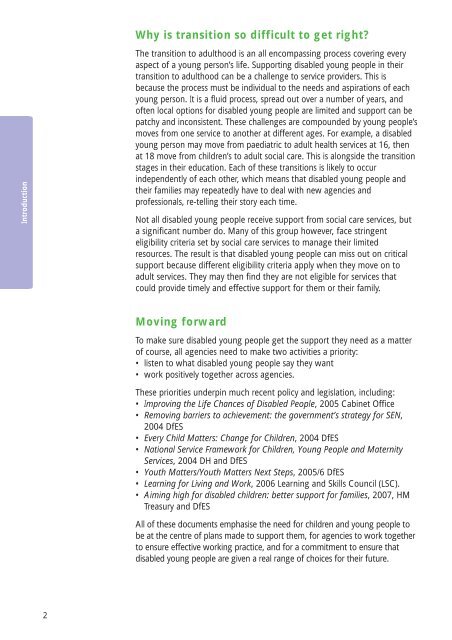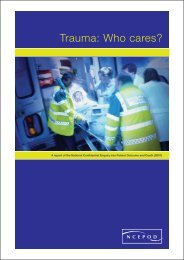A Transition Guide for All Services - Transition Information Network
A Transition Guide for All Services - Transition Information Network
A Transition Guide for All Services - Transition Information Network
- No tags were found...
Create successful ePaper yourself
Turn your PDF publications into a flip-book with our unique Google optimized e-Paper software.
Why is transition so difficult to get right?IntroductionThe transition to adulthood is an all encompassing process covering everyaspect of a young person’s life. Supporting disabled young people in theirtransition to adulthood can be a challenge to service providers. This isbecause the process must be individual to the needs and aspirations of eachyoung person. It is a fluid process, spread out over a number of years, andoften local options <strong>for</strong> disabled young people are limited and support can bepatchy and inconsistent. These challenges are compounded by young people’smoves from one service to another at different ages. For example, a disabledyoung person may move from paediatric to adult health services at 16, thenat 18 move from children’s to adult social care. This is alongside the transitionstages in their education. Each of these transitions is likely to occurindependently of each other, which means that disabled young people andtheir families may repeatedly have to deal with new agencies andprofessionals, re-telling their story each time.Not all disabled young people receive support from social care services, buta significant number do. Many of this group however, face stringenteligibility criteria set by social care services to manage their limitedresources. The result is that disabled young people can miss out on criticalsupport because different eligibility criteria apply when they move on toadult services. They may then find they are not eligible <strong>for</strong> services thatcould provide timely and effective support <strong>for</strong> them or their family.Moving <strong>for</strong>wardTo make sure disabled young people get the support they need as a matterof course, all agencies need to make two activities a priority:• listen to what disabled young people say they want• work positively together across agencies.These priorities underpin much recent policy and legislation, including:• Improving the Life Chances of Disabled People, 2005 Cabinet Office• Removing barriers to achievement: the government’s strategy <strong>for</strong> SEN,2004 DfES• Every Child Matters: Change <strong>for</strong> Children, 2004 DfES• National Service Framework <strong>for</strong> Children, Young People and Maternity<strong>Services</strong>, 2004 DH and DfES• Youth Matters/Youth Matters Next Steps, 2005/6 DfES• Learning <strong>for</strong> Living and Work, 2006 Learning and Skills Council (LSC).• Aiming high <strong>for</strong> disabled children: better support <strong>for</strong> families, 2007, HMTreasury and DfES<strong>All</strong> of these documents emphasise the need <strong>for</strong> children and young people tobe at the centre of plans made to support them, <strong>for</strong> agencies to work togetherto ensure effective working practice, and <strong>for</strong> a commitment to ensure thatdisabled young people are given a real range of choices <strong>for</strong> their future.2
















